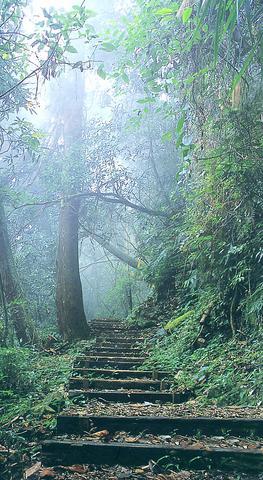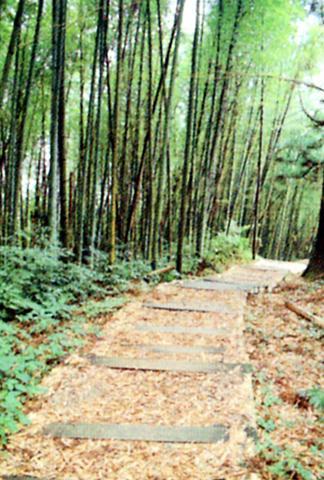An 84-year-old man was showing a bunch of city visitors how to weave a fishing net properly in the coastal village of Jhaoyang (
An 84-year-old called kiddie? No kidding! The speaker was a 98-year-old man who regards his younger village neighbors as kids, having grown up with them in the small and reclusive Jhaoyang Community (
It has a population of slightly more than 900 people, comprising around 200 Hakka families. Of these 200 families, more than 30 men or women are over 80 years old and more than 160 are over 70 years old, according to the head of the community development association Lee Shun-yi (

PHOTO COURTESY OF TAIWAN FORESTRY BUREAU
Village tour guide Li Wang-sui (
As an explanation of one of the reasons Jhaoyang villagers live so long, Li pointed to a hill at the rear of the village, affectionately known as Turtle Mountain (
Adults in the morning and children after school all enjoy hiking to the top of the hill nearly every day, to chat, pick fruits, collect flowers or run around the trails along the coast facing the Pacific Ocean. Fresh air, mild weather, frequent trail hiking and a thrifty village life naturally contribute to good health and longevity.

PHOTO COURTESY OF TAIWAN FORESTRY BUREAU
This newly renovated trail, officially called the National Jhaoyang Hiking Trail (
There are more than 100 natural hiking trails around the island and according to Lin Hao-chen (
The high mountain trails are called National Alpine Hiking Trails and one of the most popular is a 46km walk found in the Yu Shan (Jade Mountain) area. Yu Shan's highest peak is 3,952m and the tallest in the region.
Many hiking trails were opened up by the Aborigines, chiefly for hunting purposes. A number of other trails were chiseled out of heavy rocks by soldiers for military and transportation purposes. These types of trails generally have long and colorful histories, often marked by stone monuments and are known as National Historical Trails.
The famed Batongkuan (八通關) historical trail, starting from Tongpu(東埔) in Nantou County (南投縣), and meandering to Yuli (玉里) in Hualien County, was first built in 1800. The trail was widened and even flattened by Japanese soldiers in order to transport horses and to drag cannons up to high mountains to suppress Aboriginal uprisings in the early 20th century. It runs from central to eastern Taiwan by traversing the backbone of the Central Mountain Range.
Its 153km path, which usually takes an entire week to hike, is the oldest surviving trail in the country. In addition, there are hiking trails in rural areas and along the seashore. They are categorized into National Countryside Trails and National Coastal Trails.
Trails such as that of Jhaoyang belong to the former and are generally considered to be easy in hiking terms. The Makang (
One reason why the island is blessed with so many hiking trails may be because of Taiwan's unique colonial history. Ever since the 17th century, Dutch, Spanish, Chinese and Japanese soldiers have played important roles in building these trails. In fact, a number of trails were battle grounds between the Aboriginals, early Chinese settlers and foreign colonialists.
Their endeavors and sacrifices have made Taiwan's gorgeous mountains, beautiful lakes and wild hinterland much more accessible to us today. Their fascinating stories may be easily discovered and by getting closer to Taiwan's history you may also improve your health with a good, long walk.

In the March 9 edition of the Taipei Times a piece by Ninon Godefroy ran with the headine “The quiet, gentle rhythm of Taiwan.” It started with the line “Taiwan is a small, humble place. There is no Eiffel Tower, no pyramids — no singular attraction that draws the world’s attention.” I laughed out loud at that. This was out of no disrespect for the author or the piece, which made some interesting analogies and good points about how both Din Tai Fung’s and Taiwan Semiconductor Manufacturing Co’s (TSMC, 台積電) meticulous attention to detail and quality are not quite up to

April 21 to April 27 Hsieh Er’s (謝娥) political fortunes were rising fast after she got out of jail and joined the Chinese Nationalist Party (KMT) in December 1945. Not only did she hold key positions in various committees, she was elected the only woman on the Taipei City Council and headed to Nanjing in 1946 as the sole Taiwanese female representative to the National Constituent Assembly. With the support of first lady Soong May-ling (宋美齡), she started the Taipei Women’s Association and Taiwan Provincial Women’s Association, where she

Chinese Nationalist Party (KMT) Chairman Eric Chu (朱立倫) hatched a bold plan to charge forward and seize the initiative when he held a protest in front of the Taipei City Prosecutors’ Office. Though risky, because illegal, its success would help tackle at least six problems facing both himself and the KMT. What he did not see coming was Taipei Mayor Chiang Wan-an (將萬安) tripping him up out of the gate. In spite of Chu being the most consequential and successful KMT chairman since the early 2010s — arguably saving the party from financial ruin and restoring its electoral viability —

It is one of the more remarkable facts of Taiwan history that it was never occupied or claimed by any of the numerous kingdoms of southern China — Han or otherwise — that lay just across the water from it. None of their brilliant ministers ever discovered that Taiwan was a “core interest” of the state whose annexation was “inevitable.” As Paul Kua notes in an excellent monograph laying out how the Portuguese gave Taiwan the name “Formosa,” the first Europeans to express an interest in occupying Taiwan were the Spanish. Tonio Andrade in his seminal work, How Taiwan Became Chinese,